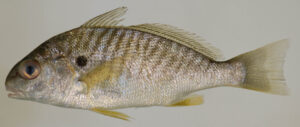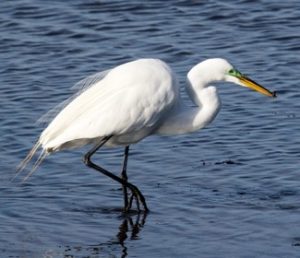Spot
Leiostomus xanthurus

Image by Robert Aguilar, Smithsonian Environmental Research Center, CC BY 2.0
Physical: Spot are a small fish with a blue-grey body, white belly, and 12-15 diagonal stripes on their back. They have a large black spot on the gill opening, where the species gets its name from. They also have a notched dorsal fin (back fin) and a forked tail. Males can make a drumming sound using their swim bladder. Adults grow to around 11 in (27.9 cm).
Habitat: Their range spans from Massachusetts to northern Mexico, with the majority of the population residing in the Chesapeake Bay and South Carolina. Spot are a migratory species, entering the Barnegat Bay and other coastal environments in the spring. They prefer sandy or mud bottoms.
Feeding: Spot are bottom feeders. Adults feed on worms, molluscs, crabs and shrimp, plants, and marine detritus. Juveniles eat tiny crustaceans.
Breeding: The spawning season lasts from late September to March. Spot gather offshore along the continental shelf. Females can lay anywhere from 100,000 to 1.7 million eggs, which then get carried back inshore by the wind, or water currents. The larvae reside in shallow tidal waters as they mature.

Sign up for email or connect through social media.